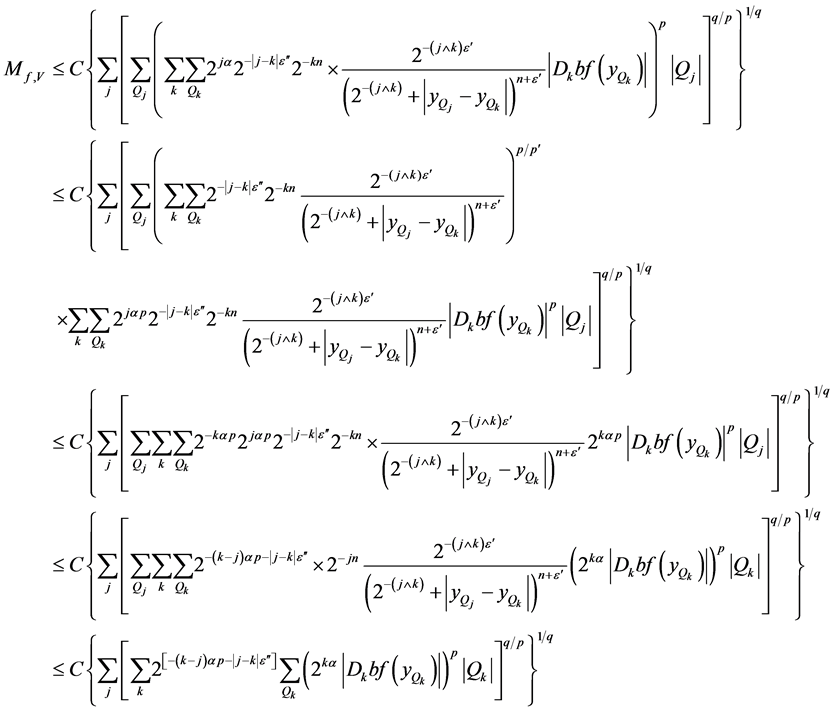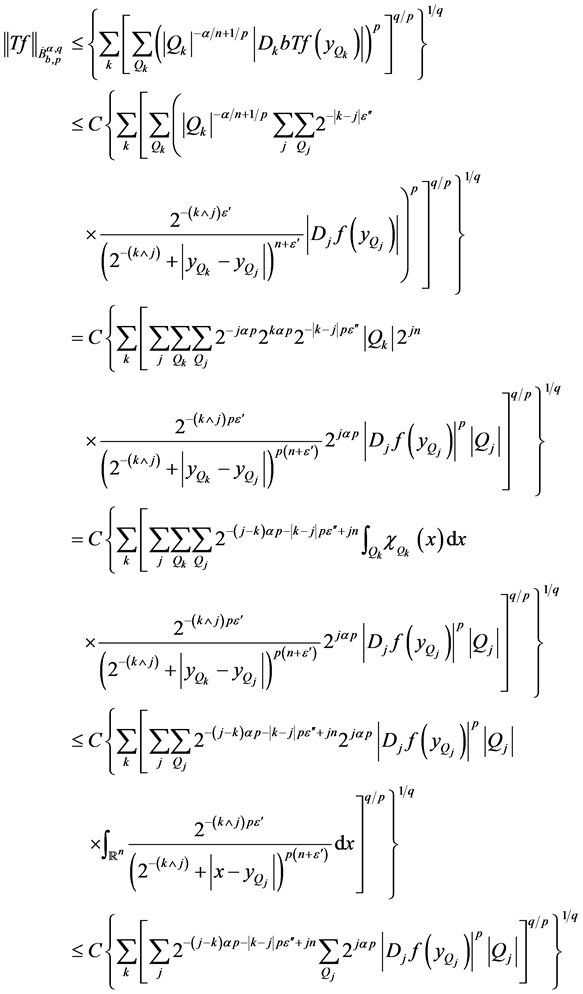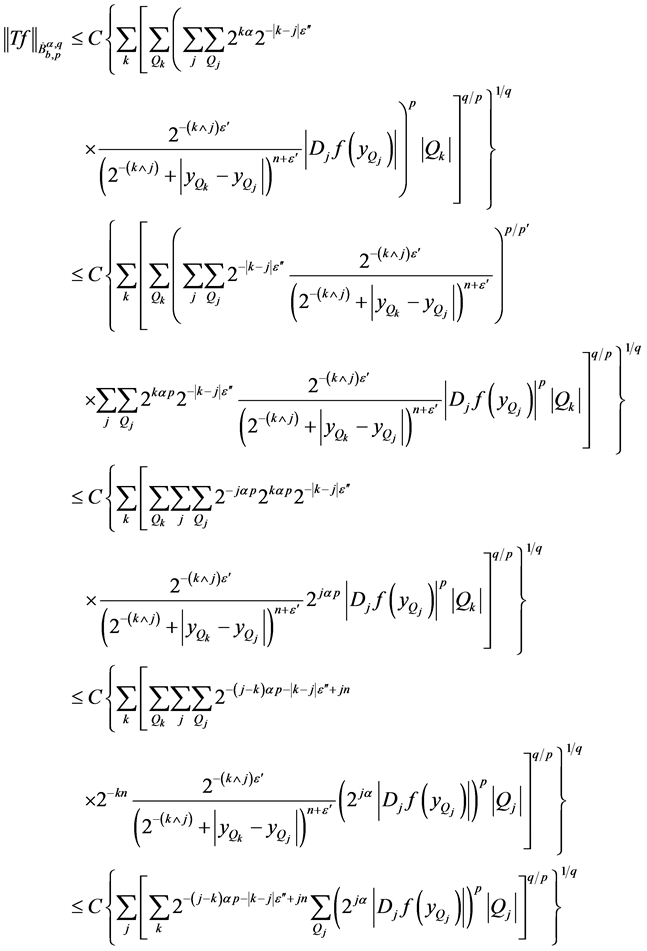A Characterization of Besov Spaces of Para-Accretive Type and Its Application ()
1. Introduction
Since Calderón and Zygmund developed the theory of singular integral opera- tors in the fifties in last century, there have been lots of eagerness to generalize the theory in various ways. One kind of interest is to consider the boundedness of such operators on Hardy spaces, Triebel-Lizorkin spaces or Besov spaces (cf. [1] - [13] ). The other interests include considering non-convolution operators such as the Calderón commutators (e.g. the
and
theorems [14] [15] ) or investigating operator-valued kernels (cf. [16] [17] [18] ).
The remarkable
theorem given by David and Journé [14] provides a general criterion for the
-boundedness of these generalized singular integral operators. Frazier, Torres, and Weiss [4] considered the
theorem on Triebel-Lizorkin spaces
, which include the classical
spaces for
and Hardy spaces
for
, under the hypothesis
for a certain condition on
. Afterward of of authors of the current paper extended the boundedness of singular integral operators acting on
to more relaxed restriction on
and
, see [12] [13] for details.
The
theorem for spaces of homogeneous type introduced by Coifman and Weiss was proved in [15] . If function 1 in the
theorem is replaced by an accretive function, a bounded complex-valued function
satisfying
almost everywhere, McIntosh and Meyer [10] showed the
boundedness of the Cauchy integral on all Lipschitz curves. David, Journé, and Semmes [15] gave more general conditions on
functions, therefore one said para-accretive functions, and proved a new
theorem by substituting function 1 for para-accretive functions. It was also shown that if
theorem holds for a bounded function
, then
is necessarily para-accretive in [15] .
In 2009, Lin and Wang [8] used a discrete Calderón-type reproducing formula and Plancherel-Pôlya-type inequality to characterize homogeneous Triebel- Lizorkin spaces of para-accretive type
. A necessary and sufficient condition of singular integral operators which is bounded from
to
,
and
with the regularity exponent
of the kernel, is also derived in [8] . In this article, we study the
boundedness of singular integral operators for wider ranges of
and
.
One begins by recalling some basic results about Calderón-Zygmund operator theory. As usual,
denotes the set of
functions with compact support and
denotes the Schwartz class.
Definition 1.1. We say that
is a singular integral operator, denoted by
, if
is a continuous linear operator from
into its dual associated to a kernel
, a continuous function defined on
, satisfying the following conditions: there exist constants
and
such that
(1)
(2)
(3)
Moreover, the operator
can be represented by
(4)
for all
with
.
We say that a singular integral operator is a Calderón-Zygmund operator if it can be extended to a bounded operator on
. Coifman and Meyer [19] showed that every Calderón-Zygmund operator is bounded on
for
.
A locally integrable function defined on
belongs to
if it satisfies
(5)
where the supremum is taken over all cubes
whose sides are parallel to the axes and
. Note that these cubes need not be dyadic. For
,
and
, let
.
Definition 1.2. Let
be a continuous linear operator.
is called to have the weak boundedness property, denoted by
, if for every bounded subset
of
, there is a constant
such that
(6)
for all
and
in
,
, and
.
David and Journé [14] gave a general criterion for the
boundedness of singular integral operators as follows:
Proposition 1.3 ($T1$ theorem for L2) Suppose that
for some
and
denotes its transpose. Then
extends to be bounded on
if and only if
,
, and
.
Before stating the
theorem of David, Journé and Semmes [15] , one recalls some definitions. Let
denote the space of continuous functions
with compact support such that
(7)
Definition 1.4. A bounded complex-valued function
defined on
is said to be para-accretive if there exist constants
such that, for all cubes
, there is a subcube
with
satisfying
(8)
Definition 1.5. Suppose
and
are bounded complex-valued functions whose inverses are also bounded. A generalized singular integral operator is a continuous linear operator
from
into
,
, for which the associated kernel
satisfies inequalities (1)-(3) such that, for all
,
with
,
(9)
Such an operator
is written as
, where
is the regularity exponent of
in Definition 1.1.
Denote
the multiplication operator by
; that is,
. David, Journé and Semmes [15] proved the following
theorem.
Proposition 1.6. (
theorem for
) Suppose that
and
are para- accretive functions and
. Then
extends to be bounded on
if and only if (1)
, (2)
, and (3)
.
Later on Lin and Wang gave the following result. For any
, let
denote the integer part of
and
. For
,
.
Proposition 1.7. ( [8] ) Assume that
is a para-accretive function. Let
and
for some
. For
,
and
, if
, then
extends to a bounded linear operator from
to
.
The main purpose and methods used in this paper is related to a
theorem in Besov spaces of para-accretive type
, which was introduced by Han [20] for
,
, by Deng and Yang [21] for
,
, denoted as
. Once one has an approximation to the identity, a Plancherel-Pôlya-type inequality follows immediately. For the terminology used in the rest of this section, see Section 2 for details.
Theorem 1.8 (Plancherel-Polya-type inequality) Let
and
. Suppose that
is an approximation to the identity defined in Definition 2.1 and
is another approximation to the identity with the same properties as the
. Set
and
.
a) For all
, if
is finite then
#Math_175# (10)
b) For all
, if
is finite then
(11)
Now it is ready to define a class of the homogeneous Besov spaces associated to para-accretive functions.
Definition 1.9. Let
be an approximation to the identity defined in Definition 2.1 and set
for
as before. For
,
, and
, the homogeneous Besov spaces of para-accretive type
is the collection of
such that
(12)
From Theorem 1.8, one can check that Definition 1.9 is independent of choices of approximations to the identity. As an application, one has the follow- ing.
Theorem 1.10. (Reduced Tb theorem for Besov spaces of para-accretive type) Assume that
is a para-accretive function. Let
and
for some
. For
,
and
, if
then
extended to a bounded linear operator from
to
.
The proof of this main result is based on the discrete Calderón-type reproduc- ing formula [5] , a characterization of Besov spaces
, and a Plancherel- Pôlya-type inequality.
This paper is organized as follows. In Section 2, one gives some preliminaries. Then one states and proves a Plancherel-Pôlya-type inequality in Section 3. Then one uses a Plancherel-Pôlya-type inequality to show norm equivalence between Besov space
and its corresponding sequence space
in Section 4. Finally one proves reduced
theorem for Besov spaces of para-accretive type in Section 5. Through the paper, one uses
to denote a dyadic cube in
,
denotes the minimum of
and
and uses
to denote a positive constant independent of the main variables, which may vary from line to line. Also
means that there exist two positive constants
and
so that
.
2. Preliminaries
Recall the definition of approximation to the identity associated to a para- accretive function and a related Calderón reproducing formula generated by such an approximation to the identity, and start with “test functions’’ given by Han [20] . Fix two exponents
and
. Suppose that
is a para- accretive function. A function
defined on
is said to be a test function of type
centered at
with width
if
(13)
(14)
(15)
Denote by
the collection of all test functions of type
centered at
with width
. For
, the norm of
in
is defined by
(16)
We denote
simply by
.
It is clear that
is a Banach space under the norm
. Write
(17)
If
and
for
, then the norm of
is defined by
. As usual, one uses
and
to denote the dual spaces of
and
, respectively. Use
to denote the natural pairing of elements
and
It is easy to check that for any
and
with equivalent norms. Thus, given
,
is well defined for all
with any
and
.
In order to state the Calderón reproducing formula, one also needs an approximation to the identity (cf. [7] [15] [20] ).
Definition 2.1. Let
be a para-accretive function. A sequence of linear operators
is called an approximation to the identity associated to
if the kernels
of
are functions from
into
such that there exist constant
and some
satisfying, for all
and all
, and
,
1)
2)
for
,
3)
for
,
4)
for
and
5)
for all
and
,
6)
for all
and
.
The following discrete Calderón reproducing formulae were given in [5] .
Proposition 2.2. Suppose that
is an approximation to the identity defined in Definition 2.1. Set
. Then there exists a family of operators
with kernel
satisfying, for
,
(18)
(19)
(20)
(21)
such that,
(22)
and
(23)
where
are all dyadic cubes with the side length
for some fixed positive large integer
and
is any fixed point in
.
Note that
if and only if
or equivalently,
if and only if
.
3. Plancherel-Pôlya-Type Inequalities
The classical Plancherel-Pôlya inequality has a long history and plays a central role in the theory of function spaces. Roughly speaking, if a tempered distribution
in
, whose Fourier transform has compact support, then, by the Paley-Wiener theorem, it is an analytic function, or more precisely, entire analytic function of exponential type. The Plancherel-Pôlya inequality concludes that if
is an appropriate set of points in
, e.g., lattice points, where the length of the mesh is sufficiently small, then
(24)
for all
with a modification if
. The Fourier transform is the basic tool to prove such an inequality. See [22] for more details.
For any cube
and
, one denotes by
the cube concentric with
whose each edge is
times as long. A generalized Plancherel-Pôlya-type inequality for Triebel-Lizorkin spaces was given in [8] . In this section, one proves the following Plancherel-Pôlya-type inequalities in Besov sense.
Proof of Theorem 1.8. By Proposition 2.2,
can be written as
(25)
where
is any fixed point in
. To estimate
(26)
using the inequality (see [7] )
(27)
where
and
are close enough to
and satisfy
, one obtains
(28)
Thus,
(29)
For simplicity, let
(30)
First one considers the case for
. In this case,
because we may choose
so that
(31)
is finite. If
, then
(32)
Note that the last inequality is followed from
(33)
and
(34)
If
, by Hölder’s inequality, one has
(35)
Next let us consider the case
, by Hölder’s inequality

For
, one uses triangular inequality and (34) again to yield
#Math_341# (36)
For
, by Hölder’s inequality and (33) again, one obtains
(37)
Since
can be replaced by any point in
, it follows that (35) still holds for
. With a modification for
, (35) holds and therefore
(38)
for
,
and
.
Conversely, if one interchanges the roles of
and
in the proof above, one immediately has
(39)
Hence
#Math_355# (40)
and therefore the proof of part (a) is finished. The proof of part (b) is the same as the one of part (a).
4. Besov Spaces of Para-Accretive Type
Recall a definition and the duals of Besov sequence spaces
introduced by Frazier and Jawerth [23] [24] . For
and
, the space
consists of all sequences
satisfying
(41)
Proposition 4.1. ( [25] [26] ) Let
,
,
. Then
(42)
with the pairing
where
and
. As usual, when
,
interprets as
.
Next one recalls the definition of almost diagonality and the boundedness of almost diagonal matrices acting on Besov sequence spaces.
Definition 4.2. For
and
, let
. one says that a matrix
is
almost diagonal, denoted by
, if there exist
and
such that, for all dyadic cubes
and
,
(43)
Proposition 4.3. ( [27] [28] ) Let
,
. If
, then
is bounded on
.
Theorem 4.4. Suppose that
is an approximation to the identity defined in Definition 2.1 and set
for
. For
,
, and
,
(44)
In particular, the definition of
is independent of the choice of approximations to the identity.
Proof. Let
and
be approximations to the identity defined in Definition 2.1. Set
and
. One wants to show that
#Math_400# (45)
By the Plancherel-Pôlya-type inequality, one has
Apply Proposition 4.3 and the Plancherel-Pôlya-type inequality again to yield
Hence
(46)
Conversely, if one interexchanges the roles
and
in the proof before, then one has
(47)
and the proof is completed.
Form the last theorem, the definition of homogeneous Besov spaces of para-accretive type is independent of the choice of approximations to the identity. For simplicity, one writes
in stead of
in the sequel.
Theorem 4.5. Suppose
,
and
.
(a) If
, then
and
.
(b) If
, then
and
.
Furthermore, if
, then the dual space of
is
and the dual space of
is
.
Proof. If
, by Proposition 2.2,
(48)
or equivalently,
(49)
By Theorem 4.4, one gets
(50)
The proof of case (b) is the same. To show the duality. By Propositions 2.2, if
and
, then
(51)
(52)
Thus
(53)
By the estimates for
, it is routine to check that the matrix
(54)
is almost diagonal defined in Proposition 4.3. Thus it is bounded on
, by Proposition 4.1. Thus
(55)
where the first inequality is followed from Propositions 4.1 and 4.3, and the second inequality is followed from Theorem 4.4. Therefore the duality follows immediately.
5. An Application
In this section one give a proof of reduced
theorem for Besov case.
Proof of Theorem 1.10. For
, by Theorem 4.4, one has
(56)
By the Calderón-reproducing formula,
(57)
Using the estimate given in [20] Lemma 3.13
(58)
implies
(59)
where
and
are close enough to
with
.
First one considers the case for
. In this case,

because one mays choose
so that
(60)
is finite. When
, one uses triangular inequality, and when
, one uses Hölder’s inequality to yield
(61)
so
is bounded from
to
for
.
Now consider the case
, by Hölder’s inequality

Similarly to this case, when
, one uses triangular inequality, and when
, one uses Hölder’s inequality. Thus
extends to a bounded linear operator from
to
.
It is clear that
, and hence
is bounded from
to
if
by Theorem 1.3 in [8] , where
is a paraproduct operator defined by
(62)
for some fixed
satisfying
and
. It is natural to ask what is the necessary and sufficient condition for the boundedness of paraproduct operators acting from
to
?
Supported
Research by author was supported by Ministry of Science and Technology, R.O.C. under Grant #MOST 105-2115-M-259-002.